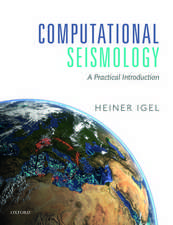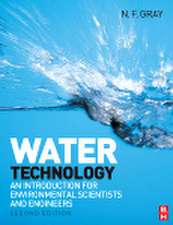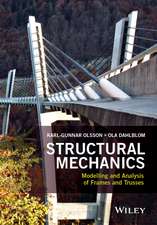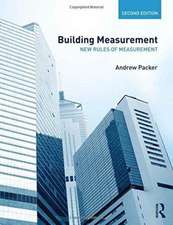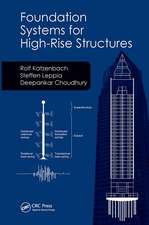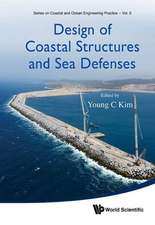Paleoseismology: International Geophysics, cartea 62
Editat de James P. McCalpinen Limba Engleză Paperback – 25 aug 1998
* First book solely devoted to paleoseismology
* Summarizes the development of the field from the 1960's to the present
* Includes a comprehensive review of the techniques currently used in paleoseismology
* Emphasizes practical methods of data collection and field studies
* Covers interpretation of field data based on current theory concerning fault segmentation and recurrence cycles
* Contains more than 170 line drawings and 50 photographs of paleoseismic phenomena
Din seria International Geophysics
- 4%
 Preț: 369.81 lei
Preț: 369.81 lei - 27%
 Preț: 443.84 lei
Preț: 443.84 lei - 23%
 Preț: 519.23 lei
Preț: 519.23 lei - 26%
 Preț: 652.08 lei
Preț: 652.08 lei - 23%
 Preț: 585.62 lei
Preț: 585.62 lei - 23%
 Preț: 436.59 lei
Preț: 436.59 lei - 23%
 Preț: 439.43 lei
Preț: 439.43 lei - 23%
 Preț: 438.68 lei
Preț: 438.68 lei - 8%
 Preț: 325.26 lei
Preț: 325.26 lei - 8%
 Preț: 395.78 lei
Preț: 395.78 lei - 27%
 Preț: 694.98 lei
Preț: 694.98 lei - 27%
 Preț: 686.70 lei
Preț: 686.70 lei - 23%
 Preț: 440.31 lei
Preț: 440.31 lei - 28%
 Preț: 348.45 lei
Preț: 348.45 lei - 27%
 Preț: 712.55 lei
Preț: 712.55 lei - 23%
 Preț: 436.30 lei
Preț: 436.30 lei - 27%
 Preț: 1236.31 lei
Preț: 1236.31 lei - 23%
 Preț: 532.18 lei
Preț: 532.18 lei - 27%
 Preț: 902.35 lei
Preț: 902.35 lei - 23%
 Preț: 549.93 lei
Preț: 549.93 lei - 30%
 Preț: 454.27 lei
Preț: 454.27 lei - 27%
 Preț: 773.45 lei
Preț: 773.45 lei - 26%
 Preț: 409.38 lei
Preț: 409.38 lei
Preț: 402.34 lei
Nou
Puncte Express: 604
Preț estimativ în valută:
76.99€ • 79.93$ • 64.20£
76.99€ • 79.93$ • 64.20£
Carte tipărită la comandă
Livrare economică 15-29 martie
Preluare comenzi: 021 569.72.76
Specificații
ISBN-13: 9780124818262
ISBN-10: 0124818269
Pagini: 588
Dimensiuni: 152 x 229 mm
Greutate: 1.7 kg
Editura: Elsevier Science
Seria International Geophysics
ISBN-10: 0124818269
Pagini: 588
Dimensiuni: 152 x 229 mm
Greutate: 1.7 kg
Editura: Elsevier Science
Seria International Geophysics
Public țintă
AUDIENCE: Academic researchers in tectonics and seismology and geological/geotechnical consultants in any country with seismic risk. Also, civil engineers, and risk analysts in federal and State agencies. Text adoption potential for courses on 'Geologic Hazards' and 'Neotectonics,' and graduate-level courses on 'Earthquake Hazards'.Cuprins
J.P. McCalpin and A.R. Nelson, Introduction to Paleoseismology. The Scope of Paleoseismology. Identifying Prehistoric Earthquakes from Primary and Secondary Evidence. Prehistoric Earthquake Recurrence and Dating. Estimating the Magnitude of Prehistoric Earthquakes. The Early Development of Paleoseismology. J.P. McCalpin, Field Techniques in Paleoseismology: Introduction. Mapping Paleoseismic Landforms. Mapping Paleoseismic Stratigraphy. Specialized Subfields of Paleoseismology. J.P. McCalpin, Paleoseismology of Extensional Tectonic Environments: Introduction. Geomorphic Evidence of Paleoearthquakes. Stratigraphic Evidence of Paleoearthquakes. Dating Paleoearthquakes. W.R. Hackett, S.M. Jackson, and R.P. Smith, Paleoseismology of Volcanic Environments: Introduction. Volcano-Extensional Structures. Criteria for Field Recognition of Volcano-Extensional Features. Paleoseismological Implications and Methods. Conclusions. G.A. Carver and J.P. McCalpin, Paleoseismology of Compressional Tectonic Environments: Introduction. Geomorphic Evidence of Thrust Paleoearthquakes. Stratigraphic Evidence of Thrust Paleoearthquakes. Paleoseismic Evidence of Secondary Faulting. Paleoseismic Evidence of Coseismic Folding. Paleoseismology of Subduction Zones. Late Quaternary Sea Level. The Coseismic Event Horizon. Paleoseismic Evidence of Coseismic Uplift. Paleoseismic Evidence of Coseismic Subsidence. R.J. Weldon II, J.P. McCalpin, and T.K. Rockwell, Paleoseismology in Strike-Slip Tectonic Environments: Introduction. Geomorphic Evidence of Paleoearthquakes. Stratigraphic Evidence of Paleoearthquakes. Dating Paleoearthquakes. S.F. Obermeier, Using Liquefaction-Induced Features for Paleoseismic Analysis: Introduction. Overview of the Formation of Liquefaction-Induced Features. Criteria for an Earthquake-Induced Liquefaction Origin. Historic and Prehistoric Liquefaction--Selected Studies. Features Generally of Nonseismic or Unknown Origin. Estimation of Strength of Paleoearthquakes. R.W. Jibson, Using Landslides for Paleoseismic Analysis: Introduction. Indentifying Landslides. Determining Landslide Ages. Interpreting an Earthquake Origin for Landslides. Analysis of the Seismic Origin of a Landslide. Interpreting Results of Paleoseismic Landslide Studies. Some Final Comments. J.P. McCalpin, Application of Paleoseismic Data to Seismic Hazard Assessment and Neotectonic Research: Introduction. Estimating Paleoearthquake Magnitude. Paleoearthquake Slip Rates and Recurrence. Fault Segmentation. Models of Fault Behavior. Models of Earthquake Recurrence. Current Issues and Future Prospects in Paleoseismology. References. Appendices. Subject Index.
Recenzii
"James McCalpin and his co-authors have made a major contribution to the literature of paleoseismology with this book. It is clearly the reference of choice to date in this exciting field... This is a wonderful book that will be used as a basic source for a generation. Buy it!"
--ENVIRONMENTAL & ENGINEERING GEOSCIENCE
"Paleoseismology is a turning point in this young but rapidly maturing disipline... The first chapter is a careful and detailed analysis of issues related to paeoseismology. Other chapters cover field techniques; paleoseismology in several types of environments, including extensional, compressional, and strike-slip tectonic environments; using landslides for paleoseismic analysis; and applying paleoseismic data to seismic hazard assessment and neotectonic research...The list of references reported at the end of the volume gives the book the feel of a well-organized book and not a simple collection of papers...a reference tool not only for new students but also for experienced specialists for years to come."
--EOS (Transactions of the American Geophysical Union)
"Paleoseismology definitely is a useful resource for researchers working on paleoseismological problems...It should be on every paleoseismologist's bookshelf."
--GEOTIMES
--ENVIRONMENTAL & ENGINEERING GEOSCIENCE
"Paleoseismology is a turning point in this young but rapidly maturing disipline... The first chapter is a careful and detailed analysis of issues related to paeoseismology. Other chapters cover field techniques; paleoseismology in several types of environments, including extensional, compressional, and strike-slip tectonic environments; using landslides for paleoseismic analysis; and applying paleoseismic data to seismic hazard assessment and neotectonic research...The list of references reported at the end of the volume gives the book the feel of a well-organized book and not a simple collection of papers...a reference tool not only for new students but also for experienced specialists for years to come."
--EOS (Transactions of the American Geophysical Union)
"Paleoseismology definitely is a useful resource for researchers working on paleoseismological problems...It should be on every paleoseismologist's bookshelf."
--GEOTIMES

